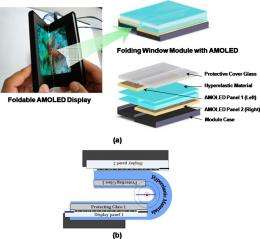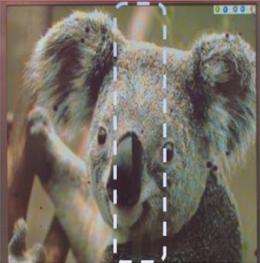May 12, 2011 feature
Foldable display shows no crease after 100,000 folding cycles

(PhysOrg.com) -- One of the most difficult problems for designing mobile devices is finding a way to minimize the size of the device while simultaneously maximizing the size of the display. To get the best of both worlds, researchers from the Samsung Advanced Institute of Technology in South Korea have designed and built a prototype of a seamless foldable display that folds in half without a visible crease in the middle.
As the researchers explain in their study, which is published in a recent issue of Applied Physics Letters, recently there has been a great deal of interest in flexible, extendable displays. Most of these flexible displays are bendable or rollable. Fabricating a display that can fold completely in half would have the advantage of providing a large screen in a small, portable form, but so far it has been a challenge to eliminate the visible crease between panels.
In the new study, the researchers have overcome this problem, demonstrating a seamless foldable active matrix organic-light-emitting-diode (AMOLED) display with no visible crease. The display consists of two AMOLED panels, silicone rubber (a hyperelastic material), a protective glass cover, and a module case. The display has a very small folding radius of just 1 mm, so that one panel lies almost completely on top of the other when the display is folded at a 180° angle. Also, the glass cover not only prevents scratches, but can serve as a touch screen, as well.
The researchers tested the foldable display’s mechanical and optical robustness by performing 100,000 folding-unfolding cycles, and found that the relative brightness at the junction decreased by just 6%. Since this difference is hardly recognizable by the human eye, the deterioration is considered negligible. As the researchers explained, the key to making a display with no visible crease involved controlling the optical properties of the materials.
“All the materials in a foldable window unit (glasses and silicone rubber) must have almost the same optical properties and attach to each other strongly without any optical property change,” coauthor HongShik Shim of the Samsung Advanced Institute of Technology told PhysOrg.com.

As for applications, a foldable display could be useful in a wide variety of small, mobile devices, such as mobile games, cellular phones, tablet PCs, and notebook PCs. The hyperelastic silicone rubber is commercially available, which could make it suitable for mass production. In addition, the researchers plan to investigate applying this design to fabricate large-size flexible displays.
“Our method has the advantage that mature, high-quality AMOLED display panels already exist,” said Shim. “But for real commercialization, some new processes and new materials must be developed, which takes about 1-2 years.”
More information: Hyuk-Jun Kwon, et al. “Mechanically and optically reliable folding structure with a hyperelastic material for seamless foldable displays.” Applied Physics Letters 98, 151904 (2011). DOI:10.1063/1.3576906
Copyright 2011 PhysOrg.com.
All rights reserved. This material may not be published, broadcast, rewritten or redistributed in whole or part without the express written permission of PhysOrg.com.





















